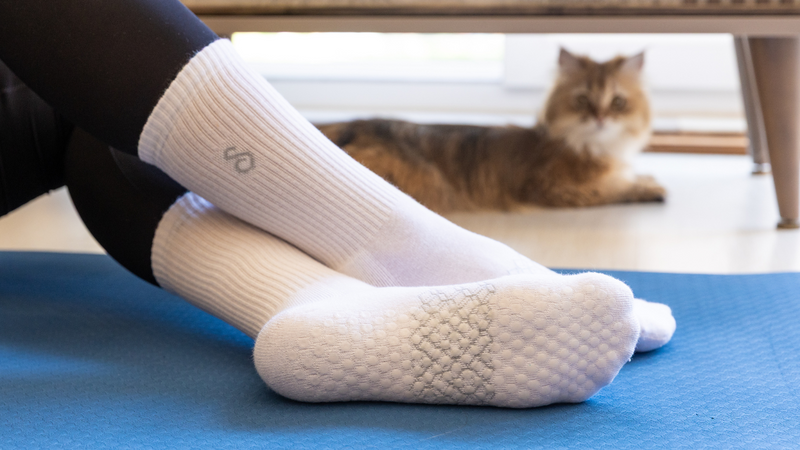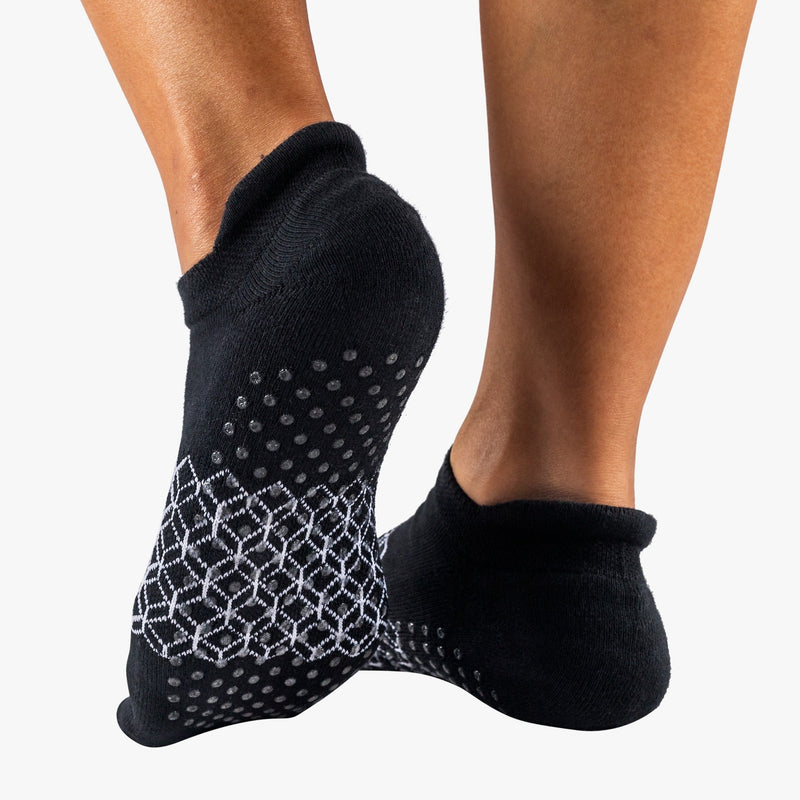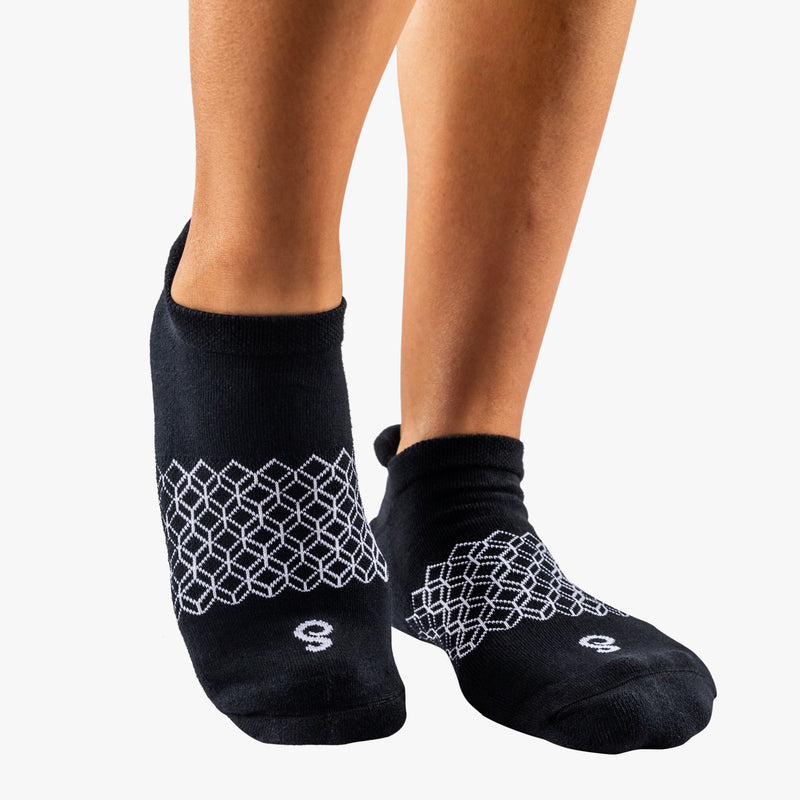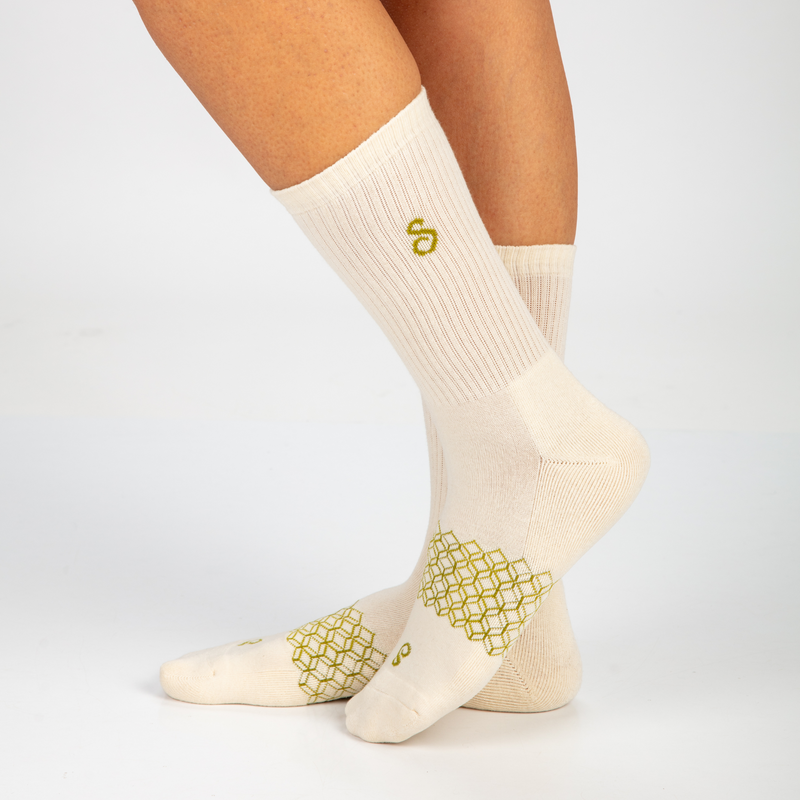
Exercise accessories often focus on high-tech gadgets and expensive equipment, yet one of the most practical additions to any workout wardrobe remains surprisingly simple.
Grip socks represent a significant upgrade from standard athletic socks, featuring specialised rubber or silicone elements on the sole that provide enhanced traction during physical activities.
These purposefully designed socks address common challenges athletes face, from maintaining stability on smooth surfaces to preventing unwanted movement within footwear.
[Shop hipSwan Non-Slip Grip Socks → ]
The growing popularity of grip socks reflects their versatility across numerous exercise disciplines, including yoga, Pilates, dance, and strength training.
Unlike traditional socks that primarily serve as a barrier between feet and shoes, grip socks actively contribute to performance enhancement whilst offering practical benefits such as improved hygiene and reduced injury risk. Their unique construction combines comfort with functionality, making them an increasingly recognised essential for both casual fitness enthusiasts and serious athletes.
1. Improved Stability and Grip
Grip socks transform how individuals move during physical activities by providing superior foot placement control. The specialised rubber or silicone patterns on the sole create friction points that connect directly with surfaces, preventing unwanted sliding movements.

Key stability benefits include:
- Reduced foot slippage during dynamic movements
- Better balance maintenance on smooth surfaces
- Enhanced confidence during challenging positions
- Improved weight distribution across the foot
The grip technology works by increasing surface contact between the foot and floor. Small raised patterns or dots grip onto equipment surfaces, creating secure anchor points that regular socks cannot provide.
Professional athletes recognise these advantages, with research showing that 72% of Premier League footballers incorporate grip socks into their training routines. This widespread adoption demonstrates the measurable performance improvements these socks deliver.
For activities requiring precise foot positioning, such as Pilates or yoga, the enhanced grip allows practitioners to focus entirely on their technique rather than worrying about foot stability. The secure footing eliminates distractions caused by slipping, enabling better exercise execution and form.
2. Enhanced Athletic Performance Through Specialised Footwear
Athletes across multiple disciplines benefit from the performance-enhancing properties of grip socks. These specialised socks function as precision tools that transform an athlete's connection with their playing surface.

Friction and Control Benefits
The textured sole patterns create superior traction between the foot and ground. This enhanced grip allows athletes to generate more power during explosive movements whilst maintaining precise control. Players can execute quick directional changes with confidence, knowing their feet remain securely planted.
Stability During Dynamic Movements
Grip socks provide crucial stability during high-intensity activities. The enhanced grip prevents feet from sliding within equipment or on surfaces, allowing athletes to maintain proper form throughout their performance. This stability proves particularly valuable during lateral movements and rapid accelerations.
Footwear Optimisation
For sports requiring specialised footwear, grip socks reduce internal movement within boots and trainers. This reduction in foot sliding creates more efficient energy transfer with each step. Athletes experience improved foot control, making their movements more deliberate and responsive.
| Performance Area | Benefit |
|---|---|
| Power Generation | Enhanced grip allows stronger push-off |
| Precision | Reduced slippage improves accuracy |
| Efficiency | Less energy wasted on foot corrections |
Comfort and Hygiene Factors
The breathable materials used in grip socks maintain foot dryness, preventing sweat-related slippage. This moisture management reduces blister formation whilst keeping feet comfortable during extended training sessions. Many fitness facilities require grip socks for hygiene purposes, making them essential equipment rather than optional accessories.
Athletes find that grip socks eliminate common distractions such as foot discomfort, allowing complete focus on performance objectives without hygiene concerns.
Enhanced Comfort and Cushioning
Grip socks feature strategically placed padding in key areas where feet experience the most stress during movement. The heel and forefoot regions receive additional cushioning to absorb impact forces.
Shock Absorption Benefits:
- Reduces impact during high-intensity activities
- Protects joints from repetitive stress
- Minimises fatigue during extended wear
This targeted padding serves multiple functions beyond basic comfort. It distributes body weight more evenly across the foot surface, preventing concentrated pressure points that often lead to discomfort or pain.
The fabric construction of grip socks typically incorporates breathable materials that regulate temperature effectively. These moisture-wicking properties maintain optimal foot climate whilst preventing overheating during physical activity.
Comfort features work together to create a supportive environment that accommodates various movement patterns. The combination of cushioning and breathable materials ensures feet remain comfortable throughout demanding activities or extended periods of wear.
Enhanced Support and Compression Technology
Many grip socks feature specialised compression elements that deliver targeted pressure to key areas of the foot. This compression technology works by applying gentle, consistent pressure that assists with blood flow and reduces fatigue during physical activity.
The compression characteristics provide several physiological benefits:
- Enhanced circulation - The graduated pressure helps promote blood return from the extremities
- Decreased inflammation - Compression can limit fluid accumulation in tissues
- Reduced muscle oscillation - The snug fit minimises unnecessary movement within the sock
These compression features prove particularly valuable for individuals who spend considerable time on their feet or experience circulation challenges. The improved blood flow contributes to better foot health and decreased discomfort during extended wear periods.
Structural Support Elements
Grip socks incorporate anatomical design features that target the foot's natural arch structure. This support system works to maintain proper foot alignment whilst providing stability during movement.
Key support benefits include:
| Feature | Function |
|---|---|
| Arch reinforcement | Maintains natural foot positioning |
| Contoured fit | Prevents internal slippage |
| Stability zones | Improves balance during activity |
The combination of compression and structural support creates a comprehensive foot care solution. These dual technologies work together to enhance comfort, reduce fatigue, and promote better foot health during both athletic activities and daily wear situations.
5. Defence Against Bacterial and Fungal Infections
Grip socks create an essential protective barrier between the skin and footwear that reduces infection risks. This barrier function becomes particularly important during physical activities when feet are exposed to moisture and bacteria.
Moisture Management Properties
The advanced materials used in grip socks excel at drawing sweat away from the skin. This moisture-wicking capability proves crucial because damp conditions create ideal environments for harmful microorganisms to multiply.
| Infection Risk Factor | How Grip Socks Help |
|---|---|
| Excess moisture | Wicks sweat away from skin |
| Bacterial growth | Creates protective barrier |
| Fungal development | Maintains drier environment |
| Direct shoe contact | Reduces skin exposure |
Antimicrobial Material Benefits
Modern grip socks often incorporate materials with natural antimicrobial properties. These specialised fabrics actively combat bacteria and fungi that commonly cause foot infections like athlete's foot.
The protective layer grip socks provide limits direct contact between feet and accumulated bacteria inside shoes. This barrier effect becomes especially valuable during extended periods of wear or intense physical activity.
Enhanced Cleanliness Standards
Regular sock materials may not offer sufficient protection against germs during demanding activities. Grip socks maintain cleaner conditions around the feet, which reduces the likelihood of developing skin problems or infections.
Athletes and active individuals particularly benefit from this protective function. The combination of moisture control and antimicrobial properties makes grip socks an effective defence against common foot infections that can develop in warm, moist environments.
Multiple Applications and Settings
Grip socks extend far beyond athletic environments, offering practical solutions across numerous daily situations. Their adaptability makes them valuable accessories for various age groups and circumstances.
Domestic environments present numerous opportunities for grip sock usage. Polished wooden floors, ceramic tiles, and laminate surfaces create slippery conditions that grip socks effectively address. The textured soles provide essential traction whilst maintaining comfort during household activities.
Mind-body practices such as yoga and Pilates benefit significantly from grip socks. These activities demand precise foot positioning and stability during transitions between poses. The enhanced grip allows practitioners to maintain proper alignment without sliding, whilst the breathable materials keep feet comfortable during extended sessions.
Healthcare settings represent another crucial application area. Hospital corridors and patient rooms often feature smooth flooring that can pose safety risks. Grip socks provide additional security for patients, visitors, and staff navigating these environments.
| Setting | Primary Benefit |
|---|---|
| Home | Safety on slippery surfaces |
| Yoga/Pilates | Stability during poses |
| Healthcare | Enhanced safety for patients |
| Travel | Hygiene and comfort |
| Childcare | Fall prevention |
Paediatric applications prove particularly valuable given children's active nature and developing coordination skills. The non-slip properties help reduce accident risks during play and daily activities.
Travel scenarios showcase grip socks' hygienic advantages. Airport security areas, hotel rooms, and public facilities often require footwear removal. Grip socks provide a protective barrier whilst maintaining traction on unfamiliar surfaces.
The multifunctional nature of grip socks demonstrates their value across diverse situations. From preventing household accidents to supporting specialised activities, these accessories adapt to various needs whilst maintaining their core safety and comfort benefits.
Common Questions
How do grip socks enhance Pilates workouts?
Grip socks deliver crucial stability and traction during Pilates sessions, allowing practitioners to maintain proper form throughout challenging movements. The anti-slip technology prevents feet from sliding on mats or studio floors, which is particularly important during transitions between poses.

Key benefits for Pilates include:
- Enhanced balance during single-leg exercises
- Improved confidence when performing flowing sequences
- Better connection between feet and mat surface
- Reduced risk of slipping during dynamic movements
The specialised grip patterns on the sock bottoms create friction that helps practitioners hold positions longer and with greater control. This stability allows for deeper engagement of core muscles, as participants can focus on proper alignment rather than worrying about foot placement.
Many Pilates instructors recommend grip socks because they enable students to perform exercises barefoot whilst maintaining hygiene standards in shared studio spaces. The moisture-wicking properties also keep feet comfortable during longer sessions, preventing the distraction of sweaty or uncomfortable feet during concentration-intensive movements.



















